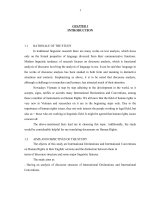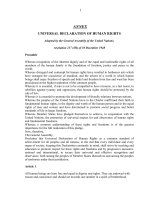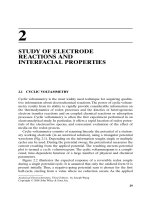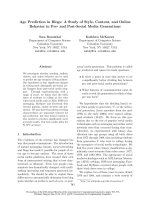Study of management policies of activities of scientific research and technological development for US corporations and companies
Bạn đang xem bản rút gọn của tài liệu. Xem và tải ngay bản đầy đủ của tài liệu tại đây (230.15 KB, 9 trang )
JSTPM Vol 1, No 4, 2012
11
STUDY OF MANAGEMENT POLICIES OF ACTIVITIES
OF SCIENTIFIC RESEARCH AND TECHNOLOGICAL
DEVELOPMENT FOR US CORPORATIONS AND COMPANIES
Dr. Bui Tien Dung
Science-Technology Management Training Institute, MOST
Abstract:
In the US, in addition to universities, national research institutes and specific research
institutes of ministries, there is a system of laboratories of corporations and companies which
carry out also fundamental researches, R&D and applied researches (making over 74% of the
total volume of science-technology (S&T) activities). This study will provide a discussion on
management policies of activities of scientific research and technological development applied
for US corporations and companies including: introduction of types of US enterprises,
orientation of entrepreneurial Government policies and management policies of S&T activities.
These US experiences may open an approach for management policies of S&T activities for
Vietnamese corporations and companies as well as for Vietnamese researchers and managers.
Keywords: Management policy; Scientific research activity; Technological development
activities; US enterprises.
1. Introduction of types of US enterprises
The US does not have the global regulation of setting up enterprises which
would be applied for all the states. The states have their own different
regulation for this matter. The law of the states for types of enterprises may be
different. From legal point of view, in the US, there is not the form of
representative offices as we have in Vietnam. Almost all the states do not
require the minimal capital for setting up enterprises. In all the states, the
formality of setting up enterprises is simple and fast. FDI enterprises and
domestic enterprises are to follow the same governing laws. There are four
types of enterprises which exist in all the states.
Sole Proprietorship: The simplest and fastest formality is applied to set up this
type of enterprises. As always, it is necessary to fill up application forms
available in all stationeries and then send to registering authorities of the state
or county. Subject to concrete requirement of each state, the applicant may be
required to send a few sets of application forms and/or certified signature. A
small registration fee should be sent together with the application forms which
can be paid by cashier’s check or money order.
12
Study of management policies of activities of scientific research…
Partnership: The formality to set up this type of enterprises as it is for Sole
Proprietorship. Enterprises of this type may have two owners or more. The
participation status of each owner decided by participating owners and it is
agreed by writing and signed by all the owners with assistance of lawyers. This
type of enterprises can be also full or limited. Full owners usually share the
ownership, work duties and liabilities and limited owners would not involved
into management decisions and would not be liable for problems raised from
decisions by managers.
Corporation: This type of enterprises is more standard. US leading enterprises
in majority are of this type. They have the independent legal status which let
them operate even when the owners cease existing. The ownership right can be
transferred to others. Enterprises of this type can issue shares to mobilize
capital, and the owners are not liable by personal assets for legal verdicts.
Limited Liability Company: It is a type of enterprises which combines the types
of partnership and corporation. This is the most popular type of enterprises in
the US. Similarly to the partnership type, Limited Liability Company exists
independently from owners in terms of legal status. Owners and managers are
nor personally liable for debts and duties of the company. Similarly, to the type
of partnership and corporation, the limited liability company does not pay
corporate income taxes, but benefits or losses of the enterprise are shared
among owners and assigned to their income for personal income taxes. The
names of these enterprises need to be ended by LLC or L.L.C or Limited
Liability Company.
2. Orientations of policies of the US Government are full of
entrepreneurship spirit
The US Government always gives priority to innovate the State management
mechanism to serve enterprises. In the book entitled Reinventing Government
[1], David Osborne and Ted Gaebler showed the model of transfer from the
power-central administrative organization to the decentralized organization.
More concretely, it is related to the transfer of management organizations
under the Government control from hierarchic administrative structure to the
new type to support and encourage development and entrepreneurship. US
scholars note ten orientations of policies which reflect the entrepreneurship
spirit, namely:
(1) The Government plays a catalyst role: focused more on “steering” rather
than “driving”;
(2) The Government is based on communities: consolidation of power rather
than direct service;
JSTPM Vol 1, No 4, 2012
13
(3) The Government exhibits a high competitiveness: creation of competition
in process to provide public services;
(4) The Government operates with pushing missions: change of organizations
heavily regulated by administrative formalities;
(5) The Government operates on result-based principles: budgets are provided
on output basis but not input basis;
(6) The Government pays attention to clients: meeting needs of citizens but
not internal demands of administrative machines;
(7) The Government takes risks: investment for increasing collection sources
but not simply for expenditures;
(8) The Government is full of precaution: preventing rather than curing;
(9) The Government is of power decentralization: transfer from administrative
hierarchy to enhancement of participation and team working;
(10) The Government operates on market orientations: application of market
mechanisms to create change driving forces.
These ten orientations of policies put down requirements to change the system
of State administrative organizations and enterprises. This can be seen through
competing capacities, effectiveness and efficiency, choices of clients,
responsibilities to explain results, common efforts and involvement of the
whole society and communities.
3. Management policies for scientific research
development applied to corporations and companies
and
technologies
Actually, every decision of the US Government, with its steering role, causes
great impacts to results of scientific research projects through macro
management policies. The attention of enterprises and researchers is not the
volume of investment by the Government for education and research but future
orientations of development of education and scientific research. The US
Government invests heavily for fundamental sciences through the Federal
budget allocations which comes up to USD90 billion per year which is almost
1% GNP (Figure 1). Solely the bio-medical research sector gets a support of
USD25 billion every year [2].
Study of management policies of activities of scientific research…
14
4000
3500
3000
2500
2000
1500
1000
500
0
Source: Chinese Ministry of Science & Technology, Jan. 2007 (OEDC) RICYT, UNESCO
Figure 1: Global expenditure for R&D (GERD) of some countries.
Together with strategies and policies for education and science development of
the US Government, during recent years, strategies and polices for scientific
research and technological development passed changes within US
corporations and companies, namely:
First, corporations and companies get linked to find solutions to new S&T
problems (during the past US corporations and companies were linked closely
with universities and specific research institutes for research cooperation and
fast use of created results of fundamental research).
Second, S&T activities within corporations and companies are not only
oriented to produce new products to meet market requirements but they are
taken as focus for success on markets.
Third, successes are not limited by S&T application to produce a concrete
product but also strategies for long-term maintenance of advanced technologies
for technological innovations.
Fourth, S&T together with innovations are put is center of visions, thoughts
and actions of enterprises and the Government - “Science is on right position”.
Fifth, policies of links mean that the solutions require the strategic partnership
relation: Federal organizations, local government agencies at various levels,
public sectors, private sectors, humanitarian services, shortly the whole country
- “All on the same boat”.
According to the report at the Europe-US Summit on science-technology and
sustainable development [2], the US Government does not support all the
JSTPM Vol 1, No 4, 2012
15
research projects because otherwise the investment capital would be spread
largely and segmented (not talking yet about possible negative sides related to
application for supports) which potentially could not lead to satisfied results of
research and expected applications. It is why the regulating actions from the
Government are highly required for macro-level management as well as
decisive actions to focus on key scientific projects. The remaining part of
enterprises is stimulated to mobilize their advantages through efforts for high
standards of products they can provide through orders from researchers about
development orientation which they proposed. For example, in sector of food
export, if they do not want to get back returned products because of the
presence of excessive residues of antibiotic or other chemicals in products they
need not only to use advanced equipment and method and apply high standards
for detection of excessive antibiotics and chemicals but also require the service
of scientists to identify new solutions to enhance the quality of their products
which would be cleaner and better than the ones offered by competitors.
For this end, the Government needs to be clear and more effective in managing
works and finding measures so that enterprises come to understand that their
better investment would be beneficial for the two reasons:
First, through enhancement of quality of products they would keep patents of
research works which could bring in secondary benefits when other enterprises
need (this situation is typical for companies in field of pharmaceutical
products, milks and animal foods).
Second, when getting orders from enterprises researchers would be more
responsible in their research works. It is quite different from the research
projects they get supports from the Government. Orders from enterprises put
researchers on position of tough competition which would lead to
development. Then research works are a kind of games where ones may win or
lose. Funds which are provided by the Government without being used
reasonably, and research works which are completed without being applied
will destroy new ideas.
In the US, for projects of scientific research in a public university get, in terms
of investment funds, only partial support from the Government and the
remaining part is supported by private corporations and companies. However,
large corporations and companies have their own research centers. Why do
enterprises do investment for research projects for these two orientations: the
Government and companies? Simply because the Government wants to raise
the living quality of people then needs to make a tougher management of
quality standards of consuming commodities, the typical case being nutrition
products and foods for a better health of the whole community. Once
enterprises want to cross this “border pass” of standards raised by the
Government and to produce good commodities to win the competition they
16
Study of management policies of activities of scientific research…
have to cooperate with scientists, and inversely, scientists if wanting to get
order from enterprises need to do hard labors. There exists, of course, a tacit
competition among scientists and researchers. However, this, as a piece of
luck, is the driving force for the social development.
In the US, the active involvement of the Government into investment for
science-technology is posed on the following criteria: First, science knowledge
is the key to future; Second, technologies are driving forces for socio-economic
development; and Third, responsibilities of the Government are to encourage
and do investments for national science-technology development.
The top priority policies for research of production technology innovations are
realized in the US under large cooperation between the Federal Government,
associations and research institutes as well as the set-up of technological
infrastructure, namely:
(1) US industrial policies focused on pushing up the research-based
development of technologies. The policies of development of technologies
provided the breakthrough in automobile industry and technical fuels
(manufacture of engines);
(2) Policies to extend the lifetime of construction works and to secure the
safety of surrounding environment (construction industry);
(3) Policies to encourage technologies, high risky but promising, which permit
to produce fully new products and services as well as their
commercialization (high techs);
(4) Policies to remove the gaps between military industrial facilities and civil
industrial facilities as well as the attention paid to priorities militaryindustrial groups can provide (investment for development of priority
technologies);
(5) Policies to provide technologies and to conduct appraisals for
implementation of projects (application of results of science-technology
research and researches produced by the Government owned laboratories).
Policies of “dual industries” are part of the State program for confidential
technologies stimulate considerably the linking process between military
industries and civil industries through removing the organizational and
technical barriers between economic sectors. Keeping line with the selected
trends of priority innovations the State strategic orientations of US policies
were defined for enhancement of competing capacities of the US economy and
science-technologies in the XXI century, namely:
(1) Securing encouraging measures from the Government for sciencetechnologies;
JSTPM Vol 1, No 4, 2012
17
(2) Forming and pushing activities of research institutes to extend the scope of
innovations. The Government facilitates the development of markets but
not changing it;
(3) Creating a favorable business environment for promotion of innovative
activities;
(4) Orienting US scientific researches on basis to meet requirements of the
economy according to allocated budgets;
(5) Providing the Government supports for US universities and higher quality
of education in schools, colleges and universities;
(6) Providing strong venture funds to terminals of technological innovations in
key sectors. Infrastructure and taxation service support the provision of
venture funds because they realize that ordinary bank services are unable to
meet financial needs for technological start-ups.
Successes of the US Government’s management policies for sciencetechnology activities were confirmed in large corporations such as Abbot, AIG,
Caterpillar, Chevron, ConocoPhillips, ExxonMobil, Ford, General Electric,
Time Warner. Hewlett-Packard, Intel, Cisco, Oracle, Apple and Microsoft have
their own laboratories for scientific research activities. According to a 2012
Report [3], the above noted corporations and companies made investment from
10-15% of turnover for purpose of scientific researches, namely:
-
Fundamental research made 6,3%. Doing investment for fundamental
research, US corporations and companies apply a special policy to select
real leaders in their fields who are experienced both in doing research
works and steering research works, particularly the ones who gathered
excellent successes in international publications;
-
Applied research made 19.6%. US corporations and companies secured
annual budgets for applied research to create future development platforms;
-
Development research made 74.1% (2012) and 70.3% (2006) (Fig. 2).
They define their system of research facilities and laboratories are based on
their own development needs, advantages and human resources.
18
Study of management policies of activities of scientific research…
80
70
60
50
40
30
20
10
0
Research institutions
Enterprises
Higher education
Other components
Source: Chinese Ministry of Science-Technology, 2007
Figure 2: Costs for development research per investment sectors of the world’s
leading nations
In their nature, corporations and companies have the path-leading role and
kick-off role for breakthrough moves of economical sectors. They are positive
factors to create competitive advantages, strength and sustainable development
of the US economy. Being in center of policies, they contribute more for
economical growth and science-technology development. Therefore, we can
summarize the whole things as follows: US management policies for scientific
research activities and technology development for corporations and companies
are applied very flexibly and effectively. They use the three most powerful
management tools, namely:
Legal tools: The US had established a progressive legal environment. The
tough norms are set up in all the fields of science and technologies including
the IP laws. The governing strucutre are highly credible and robust in all the
sectors then promote scientific research and technology development.
Administrative tools: The US had established a very favorable administrative
environment for start-ups. Million enterprises and new science-technology
ideas are tested every year. Only a minor part of them can sustain but capable
of going far and doing miracle successes.
Economic tools: The US had applied long-lasting effective and efficient
economic measures. Ordinary and direct measures of financial investment are
applied only for business-production enterprises but not for science-technology
enterprises.
JSTPM Vol 1, No 4, 2012
19
Conclusion
Management policies for activities of scientific research and technology
development which are applied for US corporations and companies show the
existence of mutual links in relations between the Government and enterprises
where the later is the necessary condition for science-technology development
and socio-economic development. Inversely, the Government is the sufficient
condition for enterprises to realize their function of use and commercialization
of research results to push up the science-technology development and socioeconomic development. In our actual context, we need to issue policies to push
up the development of enterprises and to diversify activities of scientific
research and technology development to serve enterprises. If the sciencetechnology is the driving force for socio-economic development then
enterprises should be first-ranked priorities in the strategies for sciencetechnology development./.
REFERENCE
1.
David O., Ted G. (2009) Reinventing Government. Manchusett Publisher.
2.
John P. Holdren. (2010) Policies for Science, Technologies and Innovation in Obama
Administration. Europe - US Summit of Science, Technology and Sustainable Economic
Development. Washington, DC, Sep. 2010.
3.
IBM Outlook, Sep. 2012








